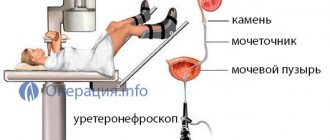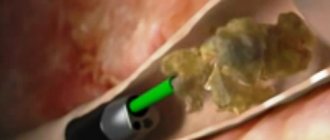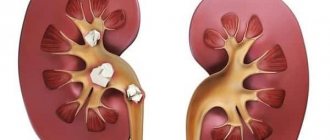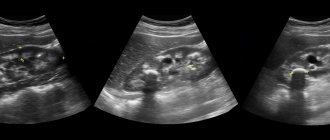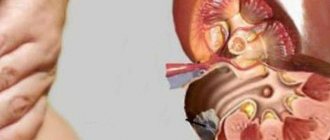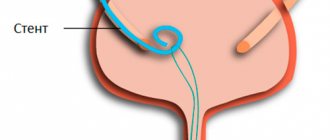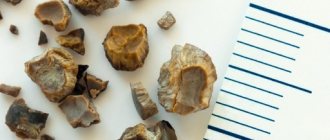Urolithiasis, accompanied by the formation of stones in the genitourinary system, can be asymptomatic for a long time. The disease makes itself felt as soon as the stones begin to scratch the internal walls of the organs or completely clog them.
One of the most unpleasant manifestations of urolithiasis is a stone entering the ureter.
Doctor with patient
It is impossible not to notice this condition, since acute severe pain begins in the groin, radiating to the lower back. Additional signs include a short-term increase in temperature and pressure, and persistent nausea. The combination of these symptoms requires immediate measures to remove the stone from the ureter.
Specialists at the Diana Medical Center use only the most modern and safe methods for this purpose and guarantee the success of the procedure.
I want to get rid of stones, do I need surgery?
Modern medicine has methods that allow you to get rid of a stone in the ureter without contact. Based on this, surgical removal of stones in our clinic is used only for special indications.
The most popular method around the world is external lithotripsy. Its essence lies in the use of acoustic waves, the action of which is directed to the location of the stone. To do this, you do not have to resort to surgical interventions. It is enough just to accurately determine the location of the stone in the ureter and act on it with a special device - a lithotripter.
Lithotripter
As a result, the specialist manages to crush the stone into many small particles, which are independently excreted from the body in the urine.
Passing stones: with and without problems
At the first sign of problems with the ureters, it is advisable to consult a doctor. Only he will be able to control how the formation behaves and how long it takes for it to leave the body. If everything proceeds normally, the patient may be recommended the following measures:
- inject an anesthetic drug to get rid of discomfort and relieve pain,
- drink an antispasmodic, which will help relax the muscles and expand the diameter of the ureter,
- lie down for a quarter of an hour in a bath with hot water, providing access to plenty of diuretic drink (a decoction of dill or bearberry seeds is especially effective),
- to help expel the stone through physical exercise - an exercise such as running up and down the stairs, as well as jumping with alternating high knees, is suitable.
After all of the above, you can go empty your bladder, substituting a container to “catch” the stone. The final step is to visit an ultrasound scan, during which the doctor will be able to understand whether the stone has completely come out and whether it has left behind destructive consequences.
If a stone is stuck at the mouth of the ureter or is too large to move, hospital and professional help can help remove it, which comes in two types:
- Conservative (for small formations): the doctor will prescribe the patient a certain medication that dissolves the stone. Additionally, the patient will have to follow the rules of a fairly strict diet and adhere to a specially designed drinking regimen. If, in addition to the fact that a stone is stuck in the ureter, an infection has also developed, the doctor will also prescribe an antibacterial medicine. If necessary, you can take painkillers.
- Operative (when the stone is located dangerously and the conservative method does not help). In the most severe cases, full-fledged surgical interventions are required, often leading to removal of the clogged ureter. Preparation for surgery - taking medications to normalize blood microcirculation, drugs from the categories of antibiotics and antioxidants. The intervention uses general anesthesia and is often accompanied by complications and blood loss. Modern operations are innovative instrumental methods that do not require direct intervention into the human body.
At home, the fight against stones in the ureter should not be carried out. An important condition for recovery: everything must be under the control of a doctor from the moment the formation is detected and the location where it may be located, to the appointment of ways to speed up the removal of the stone and the patient’s rehabilitation.
How to prepare for extracorporeal lithotripsy?
Special preparation for shock wave crushing of stone is not required. The only condition is early bowel cleansing. For this purpose, laxatives are usually prescribed on the eve of the procedure.
Taking pills
Before commencing crushing, the doctor will conduct a clarifying diagnosis. This is necessary to determine the exact location of the stone. For this purpose, contrast radiography of the kidneys, ultrasound of the kidneys or computed tomography are performed. It is recommended to carry out the shock wave crushing procedure during the period of remission, when the disease has calmed down, but in some cases it is absolutely impossible to postpone stone removal.
To avoid repetition
The formation of stones in the ureter can be prevented by prevention, which consists of the following measures:
- drinking at least 2 liters of fluid daily,
- inclusion of foods and drinks with diuretic properties in the diet,
- treatment of lesions of the genitourinary system,
- timely disposal of foci of chronic infectious diseases,
- compliance with optimal nutrition standards, fluid intake, physical activity (at least basic gymnastics should be performed every morning) and rest,
- eliminating bad habits.
And most importantly: in order to prevent a relapse of the disease, get rid of the danger of developing complications and, in general, not find out what the consequences are if a stone does not pass from the ureters, you should consult a doctor in a timely manner and begin treatment at the slightest symptoms of pathology.
Urolithiasis and stones in the ureter are a serious condition that requires medical attention with a number of therapeutic and rehabilitation measures. Even the normal movement of a calculus causes pain, as it causes the walls of the organ to expand, and if it clogs a duct, this not only causes significant pain, but also leads to a wide range of complications. That is why it is imperative to monitor your health by consulting a doctor at the first symptoms of stone advancement, so that treatment is limited to conservative measures and not surgical intervention.
How is the lithotripsy procedure performed?
After the issue with anesthesia is determined, the doctor brings the device to the location of the stone in the ureter and applies it to the side of the abdomen. Next, the lithotripter is turned on and left in operation for a period of time from 40 minutes to one and a half hours. The duration of the procedure is determined by the patient’s health status and the size of the stone being destroyed.
The procedure is most effective when treating stones ranging in size from 5 mm to 2.5 cm.
If the stone is large, it is not possible to achieve complete crushing in one procedure, so you will have to undergo lithotripsy again. The time interval between extracorporeal lithotripsy procedures is usually from 3 to 7 days.
Symptoms
Clinical signs of stones in the ureters directly depend on the size and location of the formation. If the size is small, the symptoms may not cause any discomfort. When a stone partially or completely blocks the lumen of the ureters, the symptoms become pronounced and are accompanied by:
- Severe pain in the lower abdomen.
- Fever, chills.
- Increase in body temperature to 40 degrees.
- Symptoms of body intoxication.
- Vomiting, nausea.
- Frequent and painful urge to urinate.
- Feeling of pressure in the suprapubic area.
The main symptom of a stone in the ureter is pain of moderate or severe intensity, present in the lumbar region, lower abdomen, and radiating to the groin area. In women, the pain is localized in the vaginal area, and in men - in the scrotum.
When the formation partially blocks the lumen, the pain syndrome is moderate, the pain is dull, pulling. When large in size, it disrupts the outflow of urine, causing blockage and severe intoxication of the body. An attack of renal colic, one of the common symptoms of stones in the ureter. The pain syndrome can last from 2 hours to 2 days. There are cramping pains radiating to the lumbar region, abdomen, and spine. Attacks appear suddenly after physical activity, eating spicy or fatty foods.
Is it difficult to recover after the procedure?
The main direction of post-procedural recovery is the administration of mild diuretics. The doctor also recommends drinking plenty of fluids to effectively and quickly remove individual particles of crushed stone from the body. Within a few days, the patient will notice the elimination of swelling and the complete absence of pain in the groin.
Doctor prescribes medicine
At the Diana Medical Center, shock wave crushing of stones in the ureter is carried out using the latest equipment for external lithotripsy. The procedure is performed by experienced specialists, which guarantees the safety and high efficiency of treatment of urolithiasis.
Treatment methods
If a stone is stuck in the ureter, the doctor uses the test results to determine treatment tactics. Treatment can be carried out conservatively or surgically. Drug treatment is carried out only at the stage if the stones are small. Prescribing certain medications and following a diet will help prevent relapse after the stone has passed.
As practice shows, in 80% of cases surgery is performed. Conservative therapy can expel only small stones from the ureter. If the stone is 5 mm or larger, surgery is the only treatment option. In practice, the following methods are most often used:
- Urethroscopy.
- External lithotripsy.
- Percutaneous nephrolithotomy.
- Laser crushing of stones.
The prognosis after surgery is generally favorable, but directly depends on the degree of urolithiasis, the functioning of the kidneys and other organs of the urinary system. In the postoperative period, the patient may be prescribed drug therapy and dietary nutrition for several months. All fatty and spicy foods and alcohol should be excluded from the diet. You need to reconsider not only your diet, but also your lifestyle.
What to do at home?
Drinking regime is a necessary measure to eliminate the causes of stone formation.
Small stones from the ureter can be removed at home. Removing a stone does not mean curing urolithiasis. Further measures should be aimed at eliminating the causes of stone formation. The list of necessary measures includes:
diet suitable for a certain type of stones; physical activity (doctor’s advice is required regarding this); drinking regimen (at least 2.5 liters daily); herbal medicine; medicinal baths. Return to contents
Therapeutic bath
If signs of urolithiasis are detected, renal colic torments, the passage of stones is accompanied by unbearable pain, traditional healers offer medicinal baths from herbal decoctions. In particular, they are prepared according to one recipe: 2 handfuls of the collection are poured with 3 liters of boiling water and kept on fire for 10 minutes. After 3 hours, after it has infused, add it to the bath. For this purpose, horsetail, rose hips, pine cones and branches, and oat straw are collected. Essential oils are added to warm baths: lavender, thyme, mint, chamomile.
Baths help dilate blood vessels, relax the smooth muscles of the urinary system, improve blood circulation and expand the walls of the ureter. Stones up to 7 mm can pass on their own after the first 10-15 minutes of a warm or hot bath. Longer procedures do more harm than good, since they promote profuse sweating and reduce urine output.
Return to contents
Herbal decoctions
Homemade diuretics have the gentlest effect on the body, having fewer contraindications than synthetic diuretics.
Diuretic tinctures are effective in combination with medicinal baths. It is worth considering that when stone formation is in the kidney, such decoctions can cause significant harm, pushing them to move and causing renal colic and acute inflammation. If the stone is in the ureter, this method can speed up its passage. They use herbal mixtures of juniper, rose hips, birch and madder, horsetail, rosemary, thyme, and lingonberries. Decoctions are prepared from the following ingredients:
Knotweed. 1 tbsp. l. the herbs are poured with boiling water and infused for an hour. Take a third of a glass three times a day. Crushed rose hips. 6 tbsp. l. berries or roots and 3 cups of boiling water are kept on fire for 5-7 minutes. Drink a glass an hour after meals. Dry leaves of the aspic. 1 tbsp. l. crushed product is poured with 1 cup of boiling water. Bring to a boil and leave to steep for 8 hours. Return to contents
How to remove it using modern medicine methods?
The stone removal method (lithotripsy) allows you to destroy stones in the urinary tract without interfering with the human body using instruments.
If conservative treatment fails to remove the stone from the ureter, more radical techniques are needed. In current urology, their range is quite wide: catheterization, urethroscopy, remote and contact lithotripsy, percutaneous nephrolithotomy, surgery. To understand which of them will give results in a particular case, the doctor prescribes:
general blood test; electrocardiogram; general urinalysis; urine culture; urography. Return to contents
Endovesical method
If a stone larger than 8 mm is stuck at the mouth of the ureter and cannot move on its own, catheterization is prescribed. This technology is popular among endovesical therapy. The technique is effective for difficulty urinating and renal colic. Its essence consists in introducing medications into the urinary canal that enhance peristalsis (Novocaine, Papaverine, Formitol). To achieve the result, the procedure is repeated several times; thin catheters are often used: about 50 cm long and 1-3 mm wide.
In addition, the removal of stones from the ureter can be done using electrical stimulation of the upper urinary tract through catheter electrodes. In the medical arsenal, many ureteral loops have been proposed for the removal of solid formations. They are not recommended when the stone is lodged above the iliac vessels. If these methods fail to help the patient, the orifice of the ureter is dissected, and the calculus is released within 2-3 days. According to some experts, this method entails narrowing of the ureter and reflux.
Return to contents
Urethroscopy: stone removal through the urethra
Examination of the urethra with a urethroscope probe makes it possible to see specific sites of inflammation.
If a stone no larger than 1 centimeter has reached a third of the ureter or is lodged in its lower part, ureteroscopy is resorted to. Removal of a stone from the ureter through the urethra is carried out with a flexible instrument equipped with forceps, a camera and a basket. The procedure is painless, as it is accompanied by anesthesia and occurs without a single incision; the urethroscope is inserted into the urethra naturally. After completion, a catheter is inserted to flush the urethra. A significant disadvantage of urethroscopy is severe pain after anesthesia, inclusions of blood in the urine, burning, and frequent urges, which can last up to 3 weeks. Such sensations are relieved with painkillers.
Return to contents
External lithotripsy
This term in medicine refers to the crushing of stones using a special apparatus that produces waves. When contacted, the pebble crumbles and is washed out with urine over time. The procedure is not traumatic; it is performed if the crystal does not exceed 5 mm in diameter and is clearly visible on x-rays. Among the contraindications: the onset of the inflammatory process, severe pain and blockage of the ureter. External lithotripsy is considered ineffective, since when stones are destroyed, the surrounding organ walls suffer, and repeated procedures are often necessary.
Return to contents
Contact lithotripsy
Contact lithotripsy is performed in an operating room under anesthesia, the type of which is determined individually and is determined by the patient’s age, duration of the operation, and the presence of concomitant diseases.
This method for removing stones is more effective and is considered one of the main types of stone crushing. It lies in the features of various equipment that are involved in the process:
Pneumatic - the formation is broken through the urinary canal with a destructive jet of air. Its fragments are removed with forceps through a small incision. The disadvantage of this method is that it cannot cope with dense formations. Laser - waves are directed to the stone through the urethra. The procedure is performed under general anesthesia and does not destroy the soft tissue of the ureters. The advantage is that the laser destroys even the densest rock formations. Ultrasonic - carried out using an ultrasonic device. By producing waves, it crushes stones in the ureter into sand. Return to contents
Percutaneous nephrolithotomy
If the stone in the ureter exceeds 2 cm in diameter, it is removed with instruments inserted through a small incision. The procedure is accompanied by anesthesia; the stones are removed in crushed form. The method is effective for coral formations, which are characterized by compacted and sharp edges. A nephoscope can be used to extract calcium fragments even from the kidneys. During pregnancy, inflammation and malignant tumors in the urogenitals, percutaneous nephrolithotomy is strictly prohibited.
Return to contents
Surgery
If the stones in the ureter are large and do not come out for a long time, and also provoke infectious inflammation in the urogenitals, severe pain, or block the outflow of urine, they can only be removed surgically. These are emergency measures aimed at saving the kidneys. Almost all urological departments specialize in abdominal operations, in which a specialist opens the ureter, closes the area strangulated by the stone with clamps on both sides and dissects it a little higher. After checking the patency of the canal, sutures are placed. Operations are dangerous due to hemorrhage, tissue damage, associated infections and newly formed hernias. The rehabilitation period after surgery may take up to a month.
Return to contents
